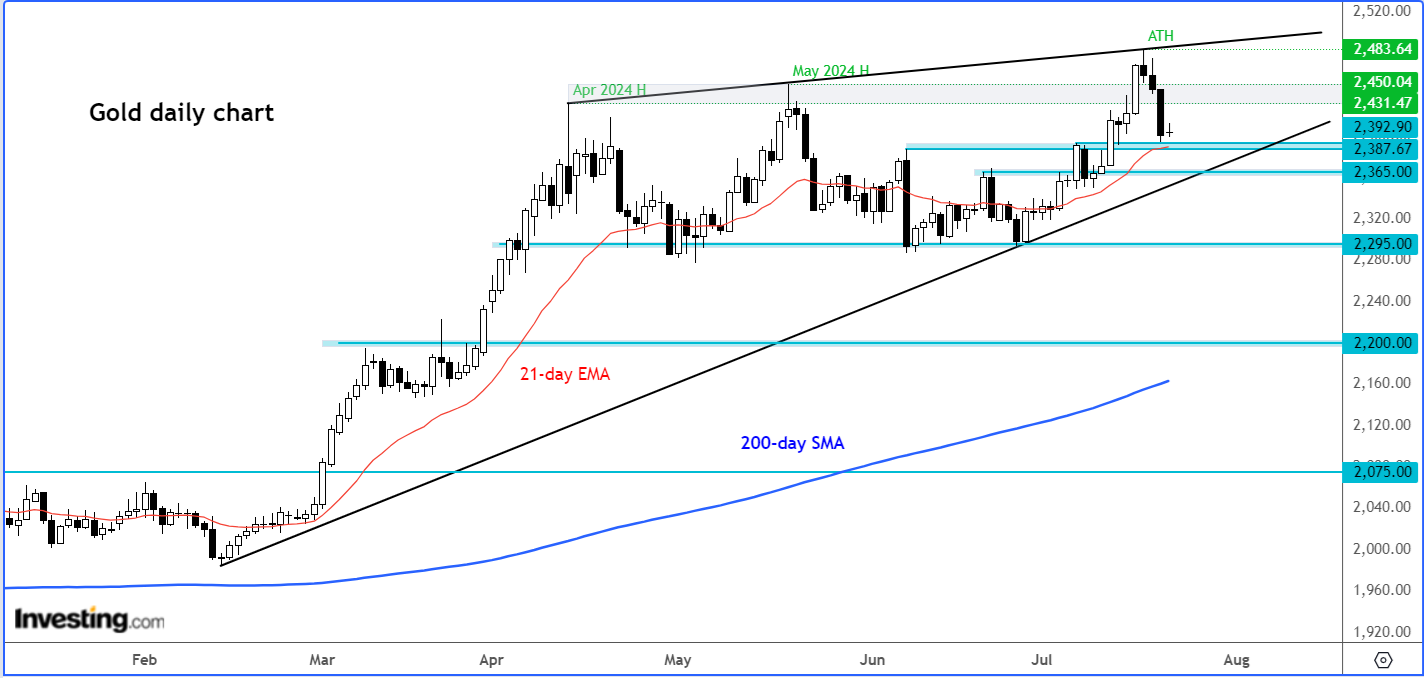- Gold's recent record highs were followed by a sharp decline, raising concerns about a peak.
- Despite this, support levels and historical patterns suggest that gold might rebound.
- Key economic events this week will be crucial in determining gold's future direction.
- Unlock AI-powered Stock Picks for Under $8/Month: Summer Sale Starts Now!
Gold's recent performance has caught the attention of many investors. The precious metal hit a record high last week but then plunged to close lower.
Its inability to hold above the previous record highs of April ($2431) and May ($2450) has raised concerns that gold may have peaked. However, there are reasons to believe that this might not be the case and that gold could potentially bounce back, possibly reaching new records soon.
Weekly Chart Analysis: Is This Another Bear Trap for Gold?
Gold's performance last week resulted in a bearish-looking inverted hammer candle on the weekly chart. This pattern, combined with its failure to maintain levels above the previous record highs, has sparked fears that gold might have hit its peak.
However, as highlighted in the chart, gold has exhibited similar bearish weekly price actions several times since Q4 2023. In most cases, there has been only modest downside follow-through, with some candles completely engulfed by the next week's price action, indicating no real control by the bears.
Last week's inverted hammer candle, although seemingly bearish, could turn out to be yet another bear trap.
Key Levels to Watch for Gold
On the daily timeframe, gold has reached potential support between $2385 and $2400, where prior resistance meets the 21-day exponential moving average (EMA).

The 21-day EMA typically offers strong support in trending markets. If this support holds, the bullish trend may continue. However, if it breaks, the next significant support level is around $2365, where the bullish trend line since February comes into play.
In terms of potential resistance, the $2450 level is crucial as gold peaked there in May and failed to hold above it last week.
Above this, last week's all-time high of $2483 and the psychologically important $2500 level are key targets for the bulls if the bullish trend resumes.
Key Economic Events to Watch This Week: PMIs, GDP, and Core PCE
This week is packed with market-moving data that could influence the dollar and gold prices. Here are the key events to watch:
Global PMIs - Wednesday
The European manufacturing sector has been struggling over the past two years, with PMIs reflecting minimal growth. Any signs of improvement will be welcomed by the markets. Additionally, the services sector PMIs, especially the prices component, will be crucial as they can be a leading indicator of inflation.
Persistent inflation in the services sector has made central banks hesitant to cut rates. If the data boosts market confidence in potential rate cuts by the ECB, BoE, and Fed, it could support gold and silver prices.
Advance US GDP - Thursday
Thursday brings the advance estimate of second-quarter GDP growth and the June core Personal Consumption Expenditure (PCE) deflator, crucial for the dollar and gold. The first quarter saw modest growth of 1.4%, with consumer spending at 1.5%. Analysts expect stronger results this time, projecting growth around 1.9%, driven by improved consumer spending, rising inventories, and stronger investments. If the economy grows closer to the expected 2%, the second half of 2024 may present challenges, potentially prompting the Federal Reserve to consider rate cuts starting in September anyway.
Core PCE - Friday
Comments from Federal Reserve officials, a cooling jobs market, and declining CPI suggest the central bank is nearing a rate cut, potentially as soon as September.
The core PCE price index, their preferred inflation measure, will be crucial on Friday. Encouraging data could bolster their confidence, but if the numbers disappoint, uncertainty will persist.
For gold, signs of persistent inflation are not necessarily bad, as investors often turn to gold to hedge against rising prices. If inflation is weaker than expected, gold may benefit from a corresponding drop in the US dollar. Thus, inflation data is unlikely to threaten gold's bullish trend.
Conclusion
Gold's recent drop may appear concerning, but historical patterns suggest it could be another bear trap. Key support levels and upcoming economic data will be critical in determining the precious metal's next move. Investors should keep a close eye on this week's events to gauge the potential impact on gold prices.
***
This summer, get exclusive discounts on our subscriptions, including annual plans for less than $8 a month!
Tired of watching the big players rake in profits while you're left on the sidelines?
InvestingPro's revolutionary AI tool, ProPicks, puts the power of Wall Street's secret weapon - AI-powered stock selection - at YOUR fingertips!
Don't miss this limited-time offer.
Subscribe to InvestingPro today and take your investing game to the next level!

Disclaimer: This article is written for informational purposes only; it does not constitute a solicitation, offer, advice, counsel or recommendation to invest as such it is not intended to incentivize the purchase of assets in any way. I would like to remind you that any type of asset, is evaluated from multiple perspectives and is highly risky and therefore, any investment decision and the associated risk remains with the investor.
